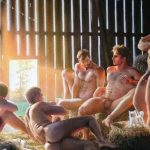The history of gay men wearing leather is deeply intertwined with the development of the modern gay male community. Leather became a symbol of rebellion, identity, and sexual expression, evolving from its utilitarian roots into a powerful cultural statement.
Post-War Era and the Rise of Leather Culture
The association of leather with gay culture began in the post-World War II era. Many returning soldiers, who had experienced a more liberated and intense environment during the war, found it difficult to reintegrate into the conservative post-war society. The motorcycle clubs that emerged during this time, particularly in the U.S., provided an alternative community for men seeking camaraderie, freedom, and a sense of belonging. The motorcycle culture’s emphasis on hyper-masculinity, ruggedness, and the leather gear that accompanied it naturally attracted some gay men who were drawn to these qualities.
The 1950s and 1960s: Leather as a Symbol of Rebellion



In the 1950s, gay men began to adopt leather as a form of resistance against societal norms. Leather attire, often associated with toughness and masculinity, was a deliberate contrast to the effeminate stereotypes imposed on gay men by mainstream culture. Wearing leather became a way for gay men to assert their masculinity and challenge the prevailing notions of what it meant to be a gay man. The leather bar scene began to develop in major cities like New York, San Francisco, and Los Angeles. These bars became safe spaces where gay men could explore their sexual identities, free from the pressures of conforming to societal expectations. The leather subculture also started to develop its own codes and rituals, such as the “Hanky Code,” which allowed men to discreetly communicate their sexual interests.
The 1970s: The Leather Scene Flourishes
The 1970s saw the leather scene flourish, particularly with the sexual revolution and the growing visibility of the LGBTQ+ community. Leather clubs, organizations, and events began to form, fostering a sense of brotherhood and solidarity within the community. The founding of organizations like the Satyrs Motorcycle Club (founded in 1954 in Los Angeles) and the emergence of annual events like the International Mr. Leather competition (first held in 1979) further solidified leather’s place within gay culture. During this time, leather was not only a fashion statement but also a symbol of sexual freedom and exploration. The leather scene became synonymous with BDSM (bondage, discipline, dominance, submission, sadism, and masochism), which was also gaining visibility during this period. For many, leather symbolized a deeper exploration of power dynamics, control, and eroticism.
The 1980s and 1990s: Leather in the Age of AIDS



The 1980s brought the AIDS crisis, which deeply affected the gay community and the leather scene. Despite the devastating impact of the epidemic, the leather community remained resilient, using its established networks and organizations to provide support and advocacy. The leather community also played a crucial role in promoting safer sex practices, incorporating them into the existing BDSM culture. The 1990s saw a resurgence of interest in the leather scene, with an increased focus on pre serving its history and traditions. Leather archives, museums, and historical societies were established to document and celebrate the contributions of the leather community to the broader gay movement.
Contemporary Leather Culture
Today, the leather scene continues to thrive as both a subculture and a fashion statement. While the leather community has diversified and evolved, it remains a vibrant part of the LGBTQ+ landscape, with events like Folsom Street Fair in San Francisco and Leather Pride festivals around the world attracting large crowds. Leather’s enduring appeal lies in its ability to symbolize strength, rebellion, and sexual freedom. It represents a unique blend of tradition and innovation, where individuals can express their identities in ways that challenge norms and celebrate diversity. The leather scene has not only shaped the history of gay culture but also continues to influence fashion, art, and sexual expression globally.
































I received this. From a friend and i will say that i did enjoy the photo’s and the history of the leather gay community, however, i am very much an. Armpit man…. I. Love the smell of a mans hot sweaty armpit odor and the look and beautiful hairy armpit…. It would have been far more interesting to me if this was all about men’s beautiful armpits and armpit odor….
https://cumm.co.uk/tag/pit-stop/